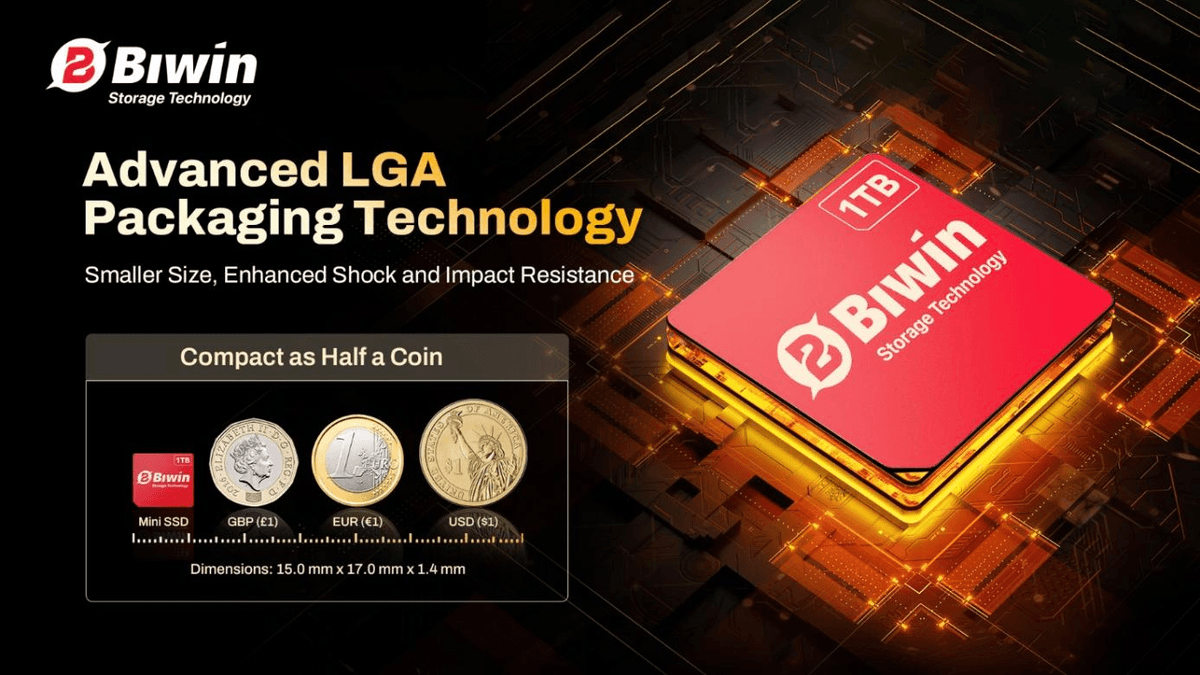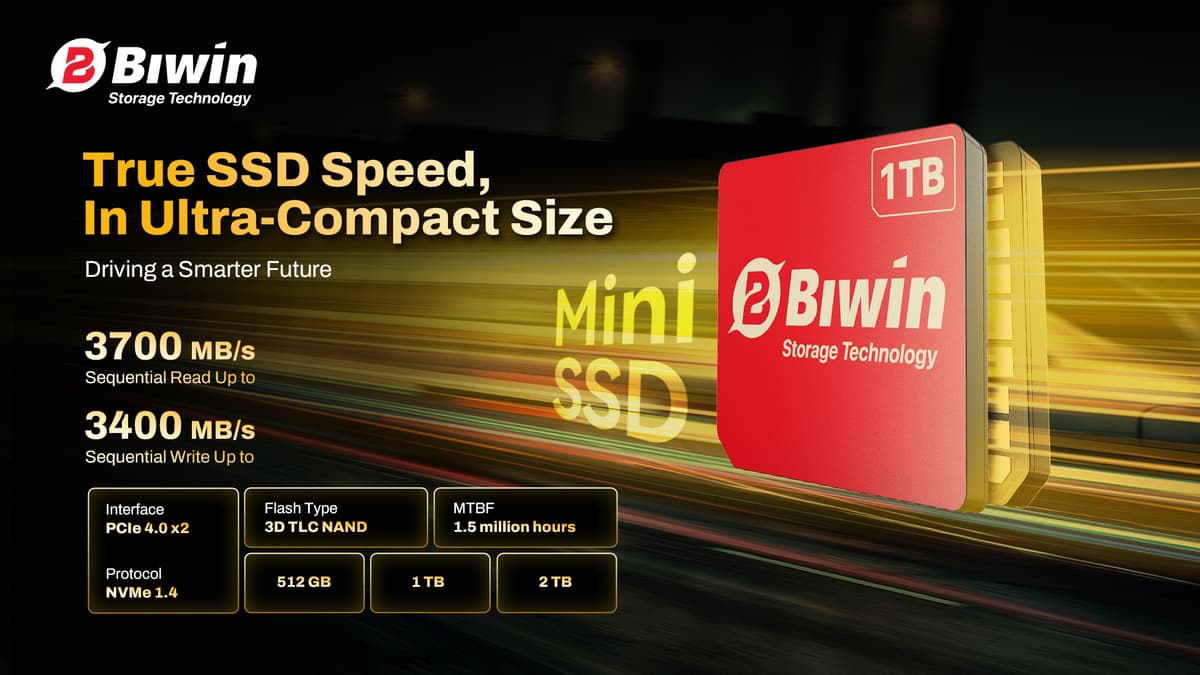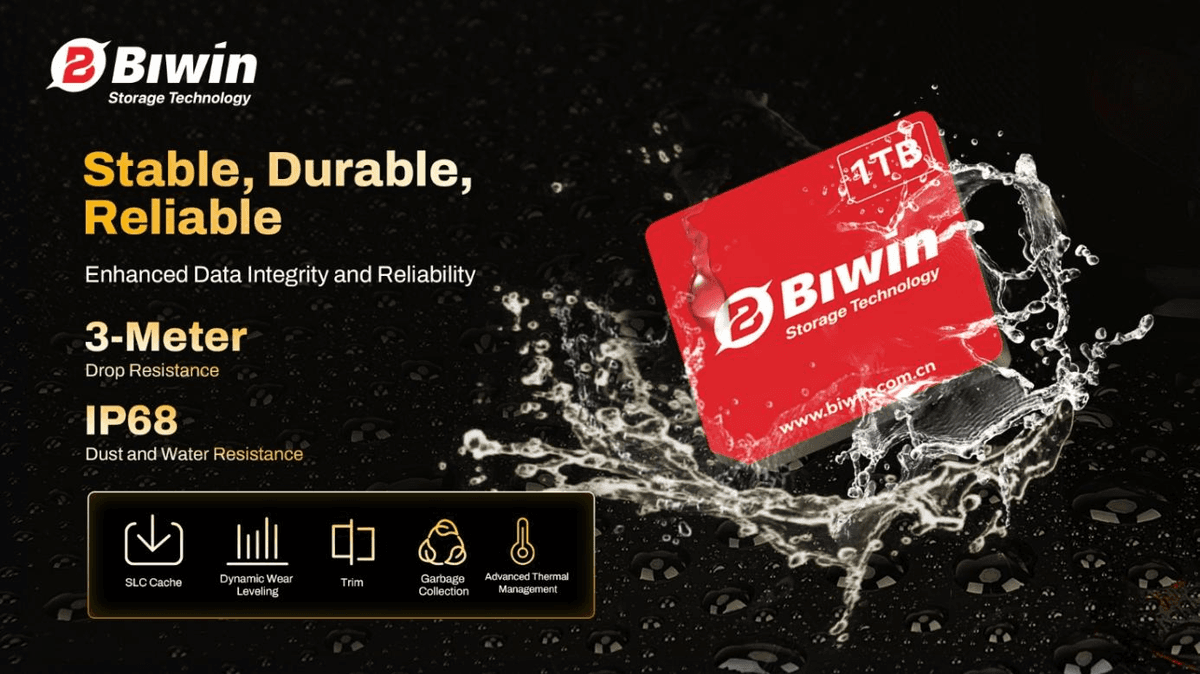
I did a double take when I saw Biwin’s new “mini SSD.” It looks like someone squeezed an NVMe drive into a slightly-larger-than-SD card and said, “Here-swap your entire PC game library like cartridges.” I’ve been juggling storage on handhelds since the original Steam Deck. On my desk right now: a Deck OLED with a 1TB microSD, a ROG Ally with a 1TB M.2 2230, and a drawer full of microSD cards labeled “Indies,” “RPGs,” and “Stuff I’ll Definitely Finish Someday.” The idea of slotting in a tiny NVMe module that actually behaves like a proper SSD? That hit me right in the quality-of-life.
Biwin is pitching this as a removable, PCIe 4.0/NVMe 1.4-compliant storage card for handheld PCs. OneXPlayer says it’ll be first to support it, and GPD has teased it too. The headline number is what got me: up to 3,718MB/s reads and 3,415MB/s writes over two lanes of PCIe 4.0. That’s not top-tier 4x PCIe speeds, but compared to microSD cards? It’s a rocket booster. And the form factor is tiny: 15 x 17 x 1.4mm-thin enough to hide in a handheld chassis without turning the device into a brick.
I’ll be honest: my knee-jerk reaction was “Oh no, another proprietary slot that we’ll all regret in two years.” But the moment it clicked was when I pictured my Steam and Game Pass libraries living on pocketable, hot-swappable (well, maybe not hot-swappable—we’ll get to that) NVMe cards. Going from the “bring a hub and an external SSD” travel life to “bring two mini SSDs in a mint tin” would be glorious. If this thing works and actually gets adopted, it could be one of those small hardware ideas that quietly improves handheld PCs for years.
The thing that grabbed me wasn’t just the speed—it was the workflow change. We’ve been living with two imperfect choices:
Biwin’s mini SSD format attempts to split the difference. Like an SD card, you insert it from the outside. Like an NVMe drive, it talks PCIe and NVMe, not SD’s protocol. It’s the first time I’ve seen a realistic pitch to make “external” storage feel native on a handheld without being a dangling USB-C drive.
The convenience angle is huge. If you’re someone who keeps three 100GB games installed and hates uninstalling to make room for the fourth, the idea of swapping a card is… liberating. I can picture my setup: one “Backlog” card for single-player RPGs, one “Live Service + Shooters” card, and one “Indie/Emu” card. Cards labeled with a label maker like it’s 2002, but at PCIe 4.0 speeds. This is the closest PC gaming has come to the console cartridge simplicity in a while.
Handheld PCs are thriving, but storage is the Achilles’ heel. Steam Deck users get excellent value but rely on microSD unless they crack the shell for a 2230 upgrade. ROG Ally and Legion Go users can do the same, and most of us do it once and never again because it’s not something you want to repeat. Meanwhile, microSD is inexpensive and fine for smaller indies, but modern AAA installs plus shader caching and asset streaming expose its limitations quickly.
There’s an SD Express spec that theoretically brings PCIe lanes to SD cards, but in practice? It’s been a ghost. The few SD Express cards we’ve seen are pricey unicorns, and device support is sparse. Biwin’s play is more pragmatic: forget SD—go pure PCIe/NVMe in a tiny, purpose-built module and ship the slot with handhelds that actually need it.
OneXPlayer going first makes sense. They iterate fast and aren’t shy about trying new hardware ideas—their audience is the adventurous crowd that doesn’t mind early adopter quirks. GPD teasing support is encouraging too. The million-dollar question: will the big volume players (Valve, ASUS, Lenovo, AYANEO) bite? If two or three of them adopt, we’re in business. If not, this could become another neat-but-niche cul-de-sac like certain proprietary camera card formats.
Biwin claims up to 3,718MB/s read and 3,415MB/s write. That’s over PCIe 4.0 with two lanes. For reference, a good PCIe 4.0 x4 2230 can hit 5,000-7,000MB/s sequential reads on paper, though thermals and controller constraints in handhelds often bring those numbers down in practice. On the other end, microSD UHS-I tops out around a couple hundred MB/s in the real world—think 90-180MB/s reads for common cards, with writes trailing. SD Express cards can approach ~1,000MB/s in ideal conditions, but they’re unicorns and adoption is thin.
So we’re looking at something that’s:
– Roughly 2-3x faster than SD Express’ typical claims and 10–20x faster than everyday microSD for sequential transfers.
– Slower than an internal x4 M.2 SSD, but not by an order of magnitude.
That delta matters differently depending on what you do:
The caveat: sequential numbers are the marketing-friendly headline. The real tell will be random IO at low queue depths (QD1–QD4)—that’s where load times and asset streaming feel snappy. NVMe has a structural advantage here over SD, but we’ll need actual benchmarks to gauge controller behavior, SLC caching, and consistency as the drive fills.

Shoving NVMe into a 1.4mm-thick card is bold. Heat has to go somewhere. Sustained writes—like installing multiple 50–100GB games back-to-back—will heat soak any compact controller and NAND. On a full-size 2230, we already see throttling in cramped handheld bays; a tiny card with less thermal mass and less copper could throttle earlier and harder.
Questions I’m watching for in first-wave units:
My hunch: swapping with the device powered off (or at least in a deep sleep) will be the recommended path, at least initially. And that’s okay. Even power-off swaps are way more convenient than cracking the shell for an M.2 drive change.
At 15 x 17mm, you’re dealing with a fingernail of PCB, NAND, controller, and a fine-pitch edge connector. That connector has to survive hundreds (ideally thousands) of insertions, resist pocket lint, and not flex or delaminate when you fumble it with cold hands at 2 a.m. on a train. I want to see:
We don’t have the full mechanical spec in public yet, but this is where the “proprietary” part matters. If Biwin wants others to adopt, the slot must be robust, manufacturable, and licenseable without drama. The card’s tiny footprint is a design win; the rest is execution.
The upside of “my entire library in a pocketable card” is obvious. The downside is equally obvious: lose the card, lose the library (and potentially your saves if they live there). On Windows handhelds, that’s a BitLocker or third-party encryption conversation. On Linux-based handhelds (SteamOS), LUKS encryption could be an option if supported. NVMe makes TRIM and smart power states straightforward, so maintenance is normal SSD best-practices territory.
Another angle: is the mini SSD bootable? In theory, sure—NVMe is bootable, and plenty of handheld BIOSes already support NVMe boot. But OEMs will decide whether the external slot is whitelisted as a boot target. Even if it is, I’d still treat the mini SSD as game/library storage, not your OS drive, unless the vendor explicitly designs for that use case.
Reported prices are ~$56 for 512GB and ~$84 for 1TB in China, with 2TB TBD. That’s in the same zip code as mainstream microSD and entry-level 2230 NVMe pricing, which is kind of wild for a first-gen proprietary format. A decent 1TB microSD often floats around $70–$100 depending on sales, while 1TB 2230 NVMe drives tend to land between $70 and $120. If Biwin can hold those prices globally, the value prop is real: pay microSD money, get NVMe speeds, and add no bulk or dangling cables.
Of course, early pricing can be teaser-friendly. NAND prices fluctuate, and regional availability will matter. If the 2TB SKU lands at a reasonable premium (say, $140–$180), that would put it in “no-brainer” territory for power users. If it creeps into boutique territory north of $200, it’ll feel less magical, especially if x4 2230 drives continue to drop.

Let’s be blunt: success requires more than OneXPlayer and a teaser from GPD. For a storage format to stick, it needs:
The risk here is obvious—if only a couple of niche handhelds support it, the ecosystem stagnates. Gamers won’t invest in a library of cards they can’t carry to a next-gen device. If Valve or ASUS put a version of this in a future Deck or Ally, it’s game on. If not, we’re talking a useful but ultimately vendor-locked accessory.
Even if it never becomes an industry-wide standard, it could be a killer feature for specific devices. Imagine a flagship OneXPlayer with two mini SSD slots: one internal 2230 for OS and evergreen titles, plus two swappable mini SSDs for seasonal games. That’s the dream for creators and reviewers too—I’d keep separate cards for testing different launchers or OS builds without nuking my daily setup.
Also: travel. The number of times I’ve left home with just “the wrong three games” installed is higher than I care to admit. An NVMe card case in the bag solves that without a USB-C octopus hanging off the handheld.
We can drool over sequential numbers all day, but the driving questions for me are:
I initially thought “x2 lanes is a compromise,” but after digging into real-world loads on handhelds, it’s the right compromise. Most handheld APU platforms limit storage performance anyway, and even x4 drives rarely sustain max sequential in those thermally constrained shells. x2 keeps power and heat manageable while still dwarfing microSD performance.
Based on the NVMe 1.4 spec and how handheld operating systems behave today, here’s my practical checklist if I were installing one:
One practical concern: the card is tiny. I’d want a small protective case—like how photographers carry SD cards—to avoid pocket lint, static, and accidental loss. If OEMs are smart, they’ll bundle a sleeve and include a dust door on the slot.
This isn’t just for benchmark chasers. The sweet spot use cases are shockingly normal:
I’m sold on the idea, but I’ve got a list of “prove it” items:
It’s tempting to call this “the microSD killer.” I wouldn’t. microSD wins on ubiquity, price at the very low end, and the fact that nearly every handheld already has a microSD slot. You can throw a $20 card in a device and get more storage today. For indie games and emulators, it’s fine. Even for some AA titles with modest asset streaming, it’s manageable.
Where microSD loses is the modern 100GB+ blockbuster. Install times balloon, shader caches drag, and traversal stutter creeps in. If you’ve been telling yourself “it’s okay” as you watch the loading bar creep along on a new Call of Duty or Phantom Liberty-sized install, an NVMe card starts to feel like a lifestyle choice rather than a luxury.
You absolutely can—and I do. A small 10Gbps USB-C SSD hits 900–1,000MB/s in the real world, which already feels far better than microSD. But there are trade-offs:

The mini SSD concept is about integration. It keeps the device self-contained, which is more “console-like” and less travel-janky.
If OneXPlayer or GPD ships a handheld I like with this slot, I’m buying at least one 1TB mini SSD on day one. I’d keep my internal M.2 for OS and a handful of “always installed” titles (my comfort food: Hades, Vampire Survivors, a Soulslike du jour), then rotate cards for the big, seasonal stuff. I’d probably skip the 512GB tier and go straight to 1TB or 2TB—handheld libraries fill faster than any of us admit.
I’ll also be watching thermals closely. I baby my handhelds; if the slot is an oven that tanks performance after five minutes, that’s a deal-breaker. But if the experience is “feels like an internal SSD most of the time,” I’m all in.
Jump in if:
– You’re planning to buy a OneXPlayer with a mini SSD slot and you’re the kind of person who keeps uninstalling games to make room.
– You hate external drives and crave a clean, integrated setup.
– You routinely install giant titles on the go and microSD makes you want to scream.
Wait if:
– You already have a 1–2TB internal 2230 and you’re happy. This won’t be faster; it’ll just be more flexible.
– You’re sensitive to first-gen quirks and value platform longevity over novelty.
– You want to see at least one more OEM (ideally a big one) commit to the slot before you invest in multiple cards.
I love clever, human-scale innovation—the kind that makes daily tech use less annoying. Biwin’s mini SSD lands squarely in that category for me. It’s not about chasing a benchmark crown; it’s about killing the friction between “what I want to play” and “what I have room for.” If performance holds under real workloads and at least a few OEMs converge on this slot, handheld PCs just got a new trick that feels overdue.
I started skeptical—another proprietary thing, great—but the more I pictured my actual routines, the more this format makes sense. It won’t replace internal M.2 drives, and it won’t make microSD vanish. It sits between them, arguably where most handheld owners live: wanting speed without surgery, capacity without clutter.
Your move, OEMs. Give this tiny card a real shot. If you do, I’ll happily retire my dongle pouch and start labeling “cartridges” again—this time with 3.7GB/s written on the side.
The mini SSD is a smart, NVMe-first take on removable storage for handhelds. It nails the convenience-speed sweet spot and is priced sensibly. Its fate hinges on adoption, sustained performance, and slot design. If those land, this could become the handheld storage upgrade to beat.
Get access to exclusive strategies, hidden tips, and pro-level insights that we don't share publicly.
Ultimate Tech Strategy Guide + Weekly Pro Tips